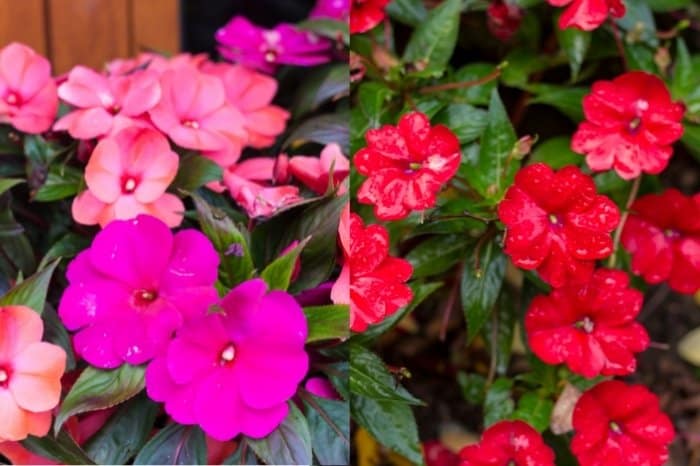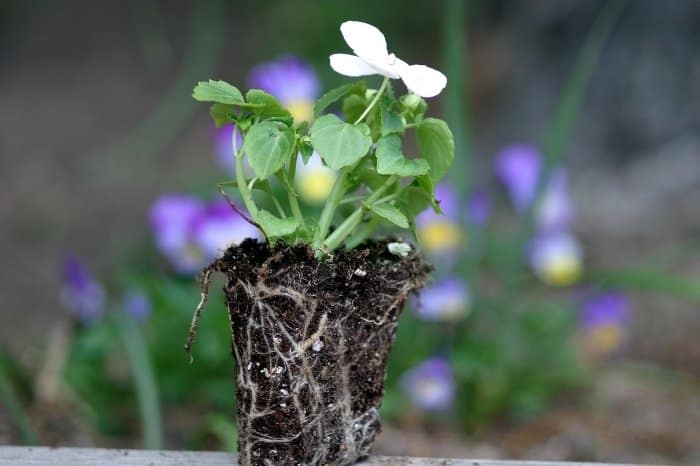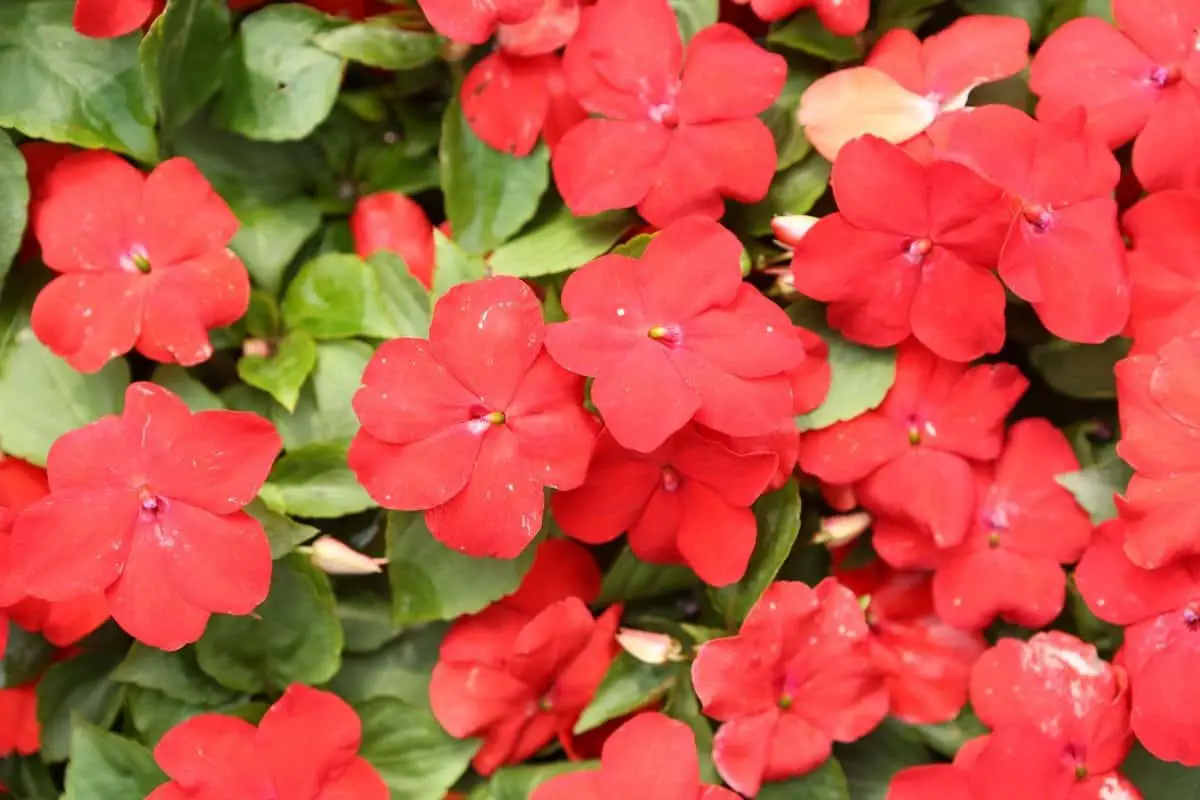Last Updated on September 18, 2021 by Cristina
This article will look at how to care for impatiens to get maximum results from these beautiful blooms.
Impatiens, also known as ‘touch me not’, thrive in shady areas and make a perfect shade garden. It can also flourish indoors as a houseplant.
A great way to enhance the entrance of your home is by using potted impatiens. These flowers are a wonderful choice when used in pots and hanging baskets.
Although they are easy to grow, they require some useful tips to ensure you have the healthiest and most colorful blooms.
Impatiens provide color all year round, from their exotic foliage and their vibrant flowers in shades of red, pink, magenta, orange, maroon, cerise, pure white, and bicolor. These flowers look great when mixed and matched or when grown in a mass display of single colors.
To get the best results, Impatiens plants require good quality soil or potting mix, regular watering, and fortnightly application of soluble fertilizer to keep the plants healthy when flowering. Care for impatiens is easy and does not require too many resources.
Two Types Of Garden Impatiens
The two common types of garden impatiens grown across America include
- Impatiens Walleriana – These are the most commonly grown cultivars with short plants, attaining a height of not more than one foot. Some types, like the ‘Super Elfin’ series, are much shorter. The standard impatiens flowers come in various colors that include red, white, pink, purple, violet, coral, and a new color, yellow. These common impatiens have much to offer that includes long-lasting blooms, shade tolerance, and brightly colored flowers in various colors. Impatiens flowers are one of the dominant plants in North America, especially in shaded areas. They are also grown in container gardens like window boxes and hanging baskets.
- Impatiens Hawkeri – This type also goes by its common name – New Guinea impatiens. It is notably larger than the standard impatiens and showier in terms of its foliage. New Guineas also love some little sunshine than the Walleriana species. Many gardeners prefer this New Guinea type in containers.

Growing Impatiens
The Best Time To Plant: If you start from seeds, sow them indoors at least 8 to 10 weeks before the last frost date. Set out your transplants in early spring after the soil has warmed up. These flowers are sensitive to low temperatures so ensure the threat of frost has passed.
The Right Place To Plant: Plant your impatiens in fertile, well-draining soils enriched with organic matter. Plant the walleriana species in light to medium shade, keeping them away from direct sunlight. The New Guinea impatiens will tolerate more sun; you only need to keep their roots moist.
The Correct Plant Spacing: Closer spacing between plants encourages taller growth, while more distance encourages them to spread out and fill gaps. Plant further apart if you are using them as a ground cover.
Growing Them In Containers: Use a general-purpose, well-draining potting soil; one with a slow-release fertilizer will keep your plants well get them off to a good start. If combining impatiens with other annuals or perennials, choose varieties with the same exposure and watering requirements.
Impatiens Flowers Care
Impatiens are easy to grow in moist, well-drained soils in shady or semi-shady locations. New Guinea impatiens tolerate more sun than the standard ones.
In the northern United States and other areas with similar cold winters, the best time for planting impatiens is Memorial Day, after the danger of frost has passed. If these flowers are planted in too cold soil, they will languish for the entire growing season.
How To Care For Impatiens
Soil Needs
Impatiens flowers prefer rich, well-drained soil enriched with organic material. The soil should drain well to avoid becoming soggy from the frequent watering that these flowers require.
Pinching Back
After planting your impatiens, it is advisable to pinch back the stems to encourage bushier growth. This is easy to do when the plants are young using your fingers.
Provide Enough Light
When provided with sufficient water, impatiens can grow in a part sun location in northerly regions. These flowers also thrive in the shade, and they are among the few readily available flowering plants that will put on a great floral display even when grown in full shade. The New Guinea type is much more tolerant of sun and can thrive in full sun if watered frequently.
Fertilizer
Impatiens flower best when regularly fertilized. Use a water-soluble fertilizer every two weeks throughout spring and summer.
You may also choose a slow-release fertilizer at the beginning of the spring and again halfway through the summer. If your plants start to look leggy in the summer, use scissors to trim off at least 1/3 of their vegetation. This promotes the emergence of new blooms and improves the overall appearance of the plants. The cause of legginess is over-fertilization.
Flower Fuel 1-34-32, 250g – The Best Bloom Booster for Bigger, Heavier Harvests
Watering
The impatiens require at least 2 inches of water per week. Suppose the temperatures are consistently above 80 degrees; the water at least 4 inches weekly. If you grow them in window boxes and hanging pots, you will need to water them daily.
Temperature And Humidity
Impatiens are quite sensitive to heat. You will need to water them regularly to help with the heat. If your temperatures are above 85 degrees Fahrenheit, you will need to provide at least 4 inches of water per week.
Container impatiens require daily watering—or twice a day if temperatures go over 85 degrees. Your Impatiens plants will look wilted if there has been a long, dry spell. Thankfully, they bounce back quickly when provided with enough water.
Impatiens are tropical plants that are sensitive to cold climates. They quickly turn to mush at the first light frost. You will need to bring them indoors if you plan to keep them during the colder months. They are fine in humid weather.
Prevent Disease
Impatiens are susceptible to root rot disease caused by overwatering. The symptoms include wilted leaves and brown lesions on the stem below the soil line. To prevent this disease from affecting your plants, do not overwater your impatiens.
Proper watering also helps prevent mildew that affects the standard variety. New Guinea is mildew-resistant. The signs of downy mildew include wilting yellow leaves with white spores. You can prevent this disease by keeping the leaves dry during watering, ensuring your plants have sufficient air circulation.

To save your plant, if you discover downy mildew on your impatiens, remove the infected plants immediately.
Conclusion
How to care for impatiens is not anything much out of your comfort zone. Its care is more general and easy compared to other plants that have more needs.
Enjoy growing your impatiens, won’t you?
Caroline is a gardener who loves to get down to the nitty–gritty of gardening. She proudly proclaims herself as a ‘dirt worshipper‘ and can often be found deep in the garden, covered in soil and singing to her plants. As a self–proclaimed ‘plant whisperer‘, Caroline believes that plants need love and attention just like any other living thing, and she loves to give them both. When she‘s not tending to her garden, you can often find her researching the latest gardening trends, or teaching others how to make their gardens thrive



